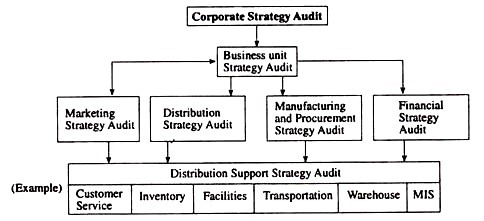This article throws light upon the three main stages of Strategy Audit Programme. The Stages are: 1. Diagnosis 2. Focused Analysis 3. Recommendations.
Strategy Audit Programme: Stage # 1 Diagnosis:
It includes the following:
(i) Reviewing key documents, such as: Strategic plan, Business or Operational plan, Organisational details, Major Policies affecting matters, such as resources allocation and performance measurement.
ADVERTISEMENTS:
(ii) Reviewing performance against yardsticks (strategically determined) and industry norms with respect to finance, market and operation—to identify major variances and emerging trends.
(iii) Gaining an understanding of:
a. Roles, responsibilities and reporting relationships,
b. Decision process and key decisions,
ADVERTISEMENTS:
c. Resources (human, physical, financial and technological),
d. Interrelationships among functional staff and operating units.
(iv) Identifying strategic implications of strategy on organisation structure, behaviour patterns, systems and processes.
(v) Defining interrelationships and linkages to strategy.
ADVERTISEMENTS:
(vi) Determining internal and external perspectives
a. By survey/focused interviews/questionnaires to assess the attitudes and feelings of management and other key personnel (internal),
b. By interview with customers and prospective customers (carefully screened sample only) and with other key external sources (e.g. society, community, fellow businessmen and the Government—highly selective) to understand as to how the company is viewed.
(vii) Identifying the very strategies that are working well and measuring degrees of success.
Strategy Audit Programme: Stage # 2. Focused Analysis:
ADVERTISEMENTS:
It includes:
(i) Ascertaining problems and assessing opportunities for improvement through an exhaustive analysis of specific issues and testing them.
(ii) Identifying interrelationship and dependencies among components of the strategic system.
(iii) Formulating conclusion as to:
ADVERTISEMENTS:
a. Weaknesses in strategy formulation or
b. Deficiencies in strategy implementation or
c. Weak or deficient interactions between the two.
Strategy Audit Programme: Stage # 3. Recommendations:
This final stage includes:
ADVERTISEMENTS:
(i) Developing alternative solutions package to problems, and means to harness opportunities.
(ii) Testing them with reference to critical factors and measures, such as: risks, rewards, priorities, resources requirements, etc.
(iii) Developing an integrated, measurable and time-phased action plan (Recommendation package) to improve strategic results.
